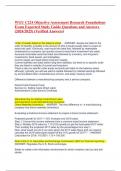Exam (elaborations)
WGU C224 Objective Assessment Research Foundations Exam Expected Study Guide Questions and Answers
- Course
- Institution
WGU C224 Objective Assessment Research Foundations Exam Expected Study Guide Questions and Answers
[Show more]



